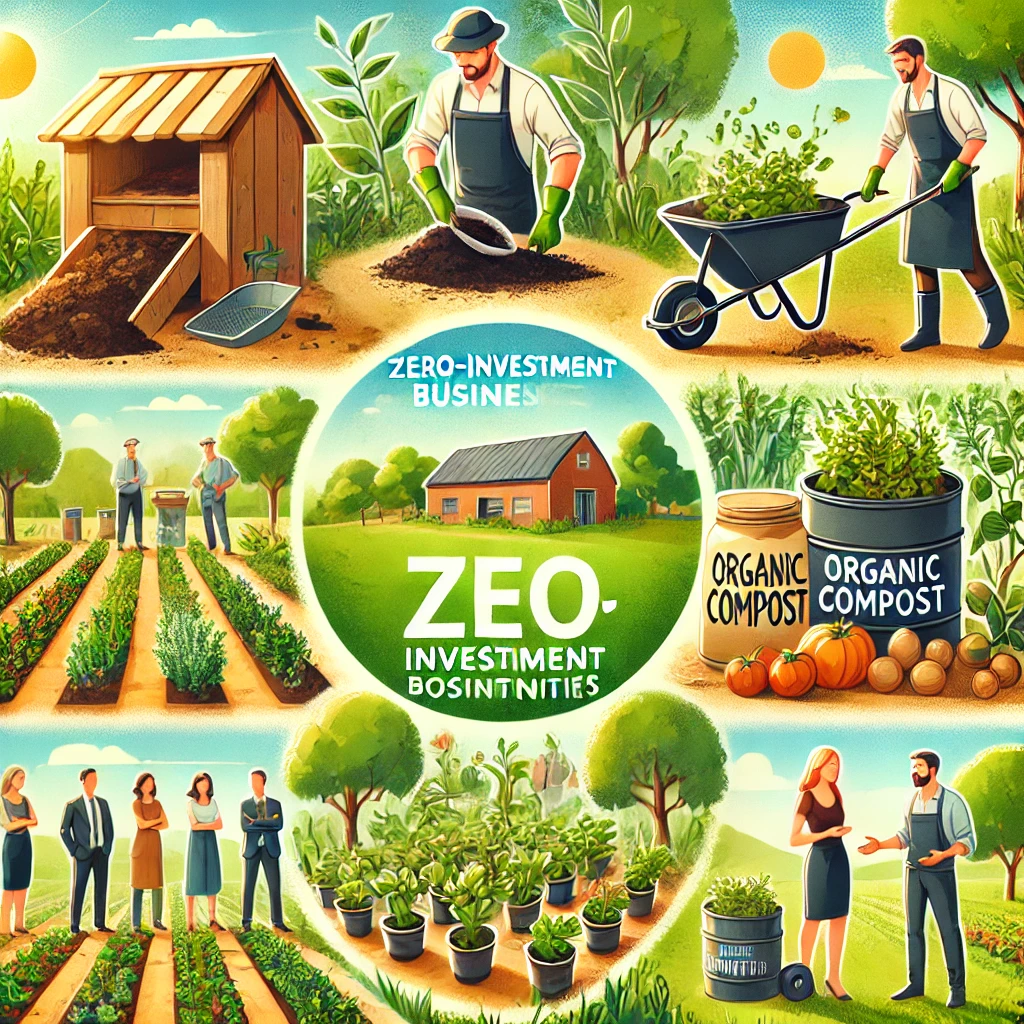Starting a business with no investment can be challenging, but it’s not impossible, especially for farmers who already have access to land, skills, and natural resources. Here are some ideas for farmers to generate income with minimal to no financial input:
1. Organic Composting Business
- How It Works: Use farm waste such as crop residues, animal manure, and kitchen waste to create organic compost. Compost improves soil fertility and is highly sought after by gardeners and organic farmers.
- Process:
- Collect farm waste and organic materials.
- Set up a simple composting area (no expensive equipment required).
- Aerate and monitor the compost pile to ensure proper decomposition.
- Package the finished compost in recycled bags or containers.
- Market: Local farmers, gardeners, and nurseries.
- Benefits: Improves soil health for your farm and provides a sustainable income source.
2. Seed Saving and Selling
- How It Works: Save high-quality seeds from your harvest and sell them to other farmers or gardeners.
- Process:
- Select the best plants for seed saving (healthy, pest-resistant, high-yielding).
- Dry, clean, and store seeds properly to maintain their viability.
- Package seeds attractively in small packets with basic instructions.
- Market: Local farmers, home gardeners, and agricultural cooperatives.
- Benefits: Provides consistent demand, especially for heirloom or organic seeds.
3. Farm Tours and Educational Workshops
- How It Works: Offer guided tours of your farm or teach farming-related skills like organic farming, beekeeping, or composting.
- Process:
- Identify your unique farming practices or features (e.g., organic methods, traditional crops).
- Promote tours or workshops through local schools, social media, or community groups.
- Charge a nominal fee for participants.
- Market: Schools, urban families, and eco-tourism enthusiasts.
- Benefits: No upfront costs if you use your farm and existing knowledge.
4. Agri-Waste Utilization
- How It Works: Convert agricultural waste into useful products like biochar, mulch, or crafts.
- Process:
- Collect waste materials (e.g., coconut husks, corn cobs, or straw).
- Create simple products: mulch for gardens, biochar for soil, or handmade crafts.
- Sell locally or at farmer’s markets.
- Market: Gardeners, farmers, and eco-conscious consumers.
- Benefits: Reduces waste and provides eco-friendly solutions.
5. Foraging and Wild Harvesting
- How It Works: Collect naturally occurring plants, herbs, mushrooms, or berries from your farm or nearby areas.
- Process:
- Identify safe-to-harvest wild plants (e.g., medicinal herbs, edible mushrooms).
- Package and label them clearly with usage instructions.
- Sell at local markets or directly to herbalists and restaurants.
- Market: Herbal medicine practitioners, local restaurants, and health-conscious consumers.
- Benefits: Requires no upfront costs beyond knowledge of local flora.
6. Custom Farming Services
- How It Works: Offer your skills and tools for tasks like plowing, pest control, or irrigation setup.
- Process:
- Promote your services to nearby small-scale farmers.
- Use your existing equipment and farming expertise.
- Charge for labor or service rendered.
- Market: Neighboring farmers and landowners.
- Benefits: Builds community relationships while generating income.
7. Livestock Breeding
- How It Works: If you already own livestock, start small-scale breeding programs.
- Process:
- Select healthy animals for breeding.
- Focus on easy-to-manage livestock like chickens, ducks, or goats.
- Sell offspring or related products (e.g., eggs, milk, chicks).
- Market: Local farmers and households.
- Benefits: Requires minimal extra resources if you already have livestock.
8. Herbal or Medicinal Plant Cultivation
- How It Works: Grow medicinal plants like tulsi, aloe vera, lemongrass, or mint.
- Process:
- Use a small portion of your land to grow fast-growing, low-maintenance herbs.
- Harvest and sell fresh or dried herbs.
- Partner with local markets, herbalists, or online sellers.
- Market: Health stores, wellness practitioners, and local markets.
- Benefits: These plants often require less water and maintenance.
9. Local Food Delivery
- How It Works: Deliver fresh produce to customers in your area.
- Process:
- Use your existing harvest to fulfill orders.
- Promote your service through word-of-mouth or social media.
- Deliver produce directly using a bicycle or existing transportation.
- Market: Local families, restaurants, and community groups.
- Benefits: Builds a loyal customer base while cutting out middlemen.
10. Value Addition
- How It Works: Process raw farm products into value-added goods like jams, pickles, or dried fruits.
- Process:
- Use surplus or seasonal produce.
- Follow simple, traditional methods for preservation.
- Package products attractively and sell locally.
- Market: Farmers’ markets, local stores, and online platforms.
- Benefits: Increases the market value of your produce.
11. Beekeeping
- How It Works: Start small-scale beekeeping to produce honey, beeswax, and pollination services.
- Process:
- Set up a few beehives on your land.
- Use natural flora or flowering crops to feed bees.
- Harvest honey and beeswax for sale.
- Market: Local markets, health food stores, and individual buyers.
- Benefits: Enhances farm productivity through pollination and provides a high-value product.
12. Social Media Farming Content
- How It Works: Share your farming practices, tips, or lifestyle online through platforms like YouTube, Instagram, or TikTok.
- Process:
- Create content using a smartphone.
- Focus on unique or relatable aspects of your farm life.
- Build a following and monetize through ads, sponsorships, or selling digital guides.
- Market: Online viewers and agricultural enthusiasts.
- Benefits: Requires only time and creativity to start.
